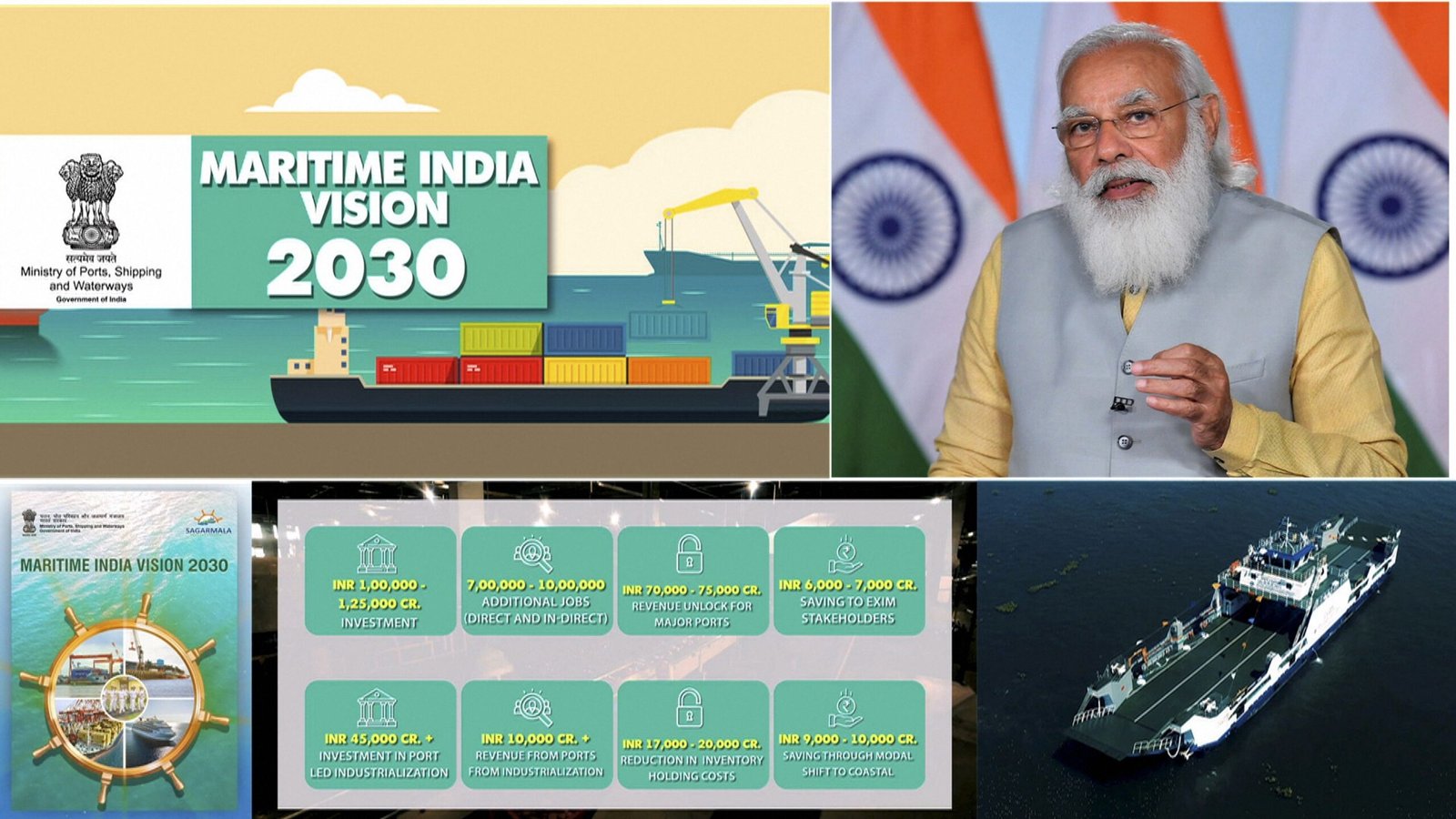Context
- According to recently released World Bank’s Logistic Performance Index (LPI) Report 2023, India (overall ranked 38th)has moved up to 22nd rank in the global rankings on the “International Shipments” category from the 44th position in 2014.
- The global recognition of the operational efficiencies of Indian ports and the Indian maritime sector is an important step in India’s endeavour to become a global maritime power as envisaged in the Maritime India Vision, 2030.
Maritime India Vision, 2030
- A10-year blueprint with the aim of overhauling the Indian maritime sector, the vision was launched at the Maritime India Summit in November 2020.
- It is the latest venture of the Sagarmala Programme which outlines a series of policy initiatives and development projects.
- The development project will see an investment of Rs. 3.4 lakh crore to increase cargo volumes to the tune of 2600 million tones.
- This will lead to the creation of additional jobs (direct or indirect) and create more sources of revenue of about 20,000 cores for state-owned major ports.
Factors Contributed to Improved Performance in Recent LPI Report
- Substantial Reduction in Dwell Time
- The dwell time (the amount of time vessels spends in port actively loading or unloading cargo) has been substantially reduced at Indian ports.
- This has reached an optimum level of about 3 days only as compared to 4 days in countries like the UAE and South Africa, 7 days in the US and 10 days in Germany.
- Improvement in Port Operational Efficiency
- India has done well in another parameter that measures port operational efficiency.
- The country’s average turnaround time (TRT) of only 0.9 days is amongst the best in the world.
- In Belgium, Germany, the UAE, Singapore, Malaysia, Ireland, Indonesia, and New Zealand it is 1.4 days, in the US 1.5 days, etc.
- Improved Connectivity to Hinterland
- Focus on improving connectivity to the hinterland through coordinated planning and execution under the PM Gati-Shakti National Master Plan has propelled Indian port sector.
- This has made shipping easy from remote parts of the country.
- Other contributing factors
- Large investments in the upgradation of infrastructure in the ports and shipping sector in the past few years.
- There has been a consistent focus on improvements in port efficiency and productivity through reforms, induction of new technologies, a greater thrust on public-private partnership (PPP) and an overall commitment to the ease of doing business.
Current Operational Efficiency of Indian Ports
- The capacity at 12 major ports in the country has increased from 871 million metric tonnes (MMT) in 2015 to 1,617 MMT in 2023.
- The total capacity of Indian ports has gone up from about 1,560 MMT in 2015 to more than 2,600 MMT.
- There has also been a nearly 150 per cent increase in the value of operationalisation of PPP projects in the major ports — from about Rs 16,000 crore in 2015 to more than Rs 40,000 crore in 2022-23.
Reason Behind Improvement in Port Operational Efficiency
- PPP Projects
- The PPP projects have contributed significantly to the increased operational efficiencies while adding nearly 300 MMT extra capacity during this period.
- They handle nearly 54 per cent of the total cargo in the major ports.
- National Logistics Portal (Marine): It is a single-window digital platform for all stakeholders including those engaged in cargo services, carrier services, banking and financial services, and government and regulatory agencies.
- Sagar Setu App: The app along with National Logistics Portal (Marine) facilitates seamless movement of goods and services in ports while substantially enhancing the ease of doing business.
Some other key policies and legislative reforms to boost the port sector
- Major Port Authorities Act, 2021 which grants greater autonomy to major ports.
- The Marine Aids to Navigation Act, 2021 that provides for increased safety and efficiency in vessel traffic services and training and certification at par with international standards.
- The Indian Vessels Act, 2021 which brings uniformity in law and standardised provisions across all inland waterways in the country.
- The government is also in the process of replacing the Indian Ports Act, 1908 with a piece of legislation that is in tune with present-day requirements.
Decarbonisation in the Maritime Sector
- The focus on decarbonisation in the maritime sector along with the Panchamrit commitments of the government has reflected in the port sector.
- There has been a 14-fold increase in the use of renewable energy in major ports over the last eight years.
- Four of the major ports now generate more renewable energy than their total energy needs.
- The Harit Sagar Green Port guidelines issued by the government is another important step further in this direction.
- It aims to bring about a paradigm shift towards safe, efficient, and sustainable ports while implementing sound environmental practices among all stakeholders.
- The Green Port Project aims to make the industry fuel-efficient, and a cleaner mode of transportation. The plan involves:
- Implementation of sustainable practices in terminal design, development, and operation;
- Preparation of environment management and monitoring plan;
- Regulation of the discharges and effluents in the harbour water and minimization through Swachh Bharat initiatives, large plantation activities around port areas, etc.
- Promotion of renewable power for port activities by installation of solar power plants, rooftop solar, wind farms, floating solar plants, etc.
- Construction of Multi-Modal Terminal at Jogighopa (Assam), etc.
Conclusion
- Over the past few years, the government has endeavoured to develop ports as hubs of economic activity.
- Improvement in World Bank ranking on ports reflects steps taken in maritime sector





